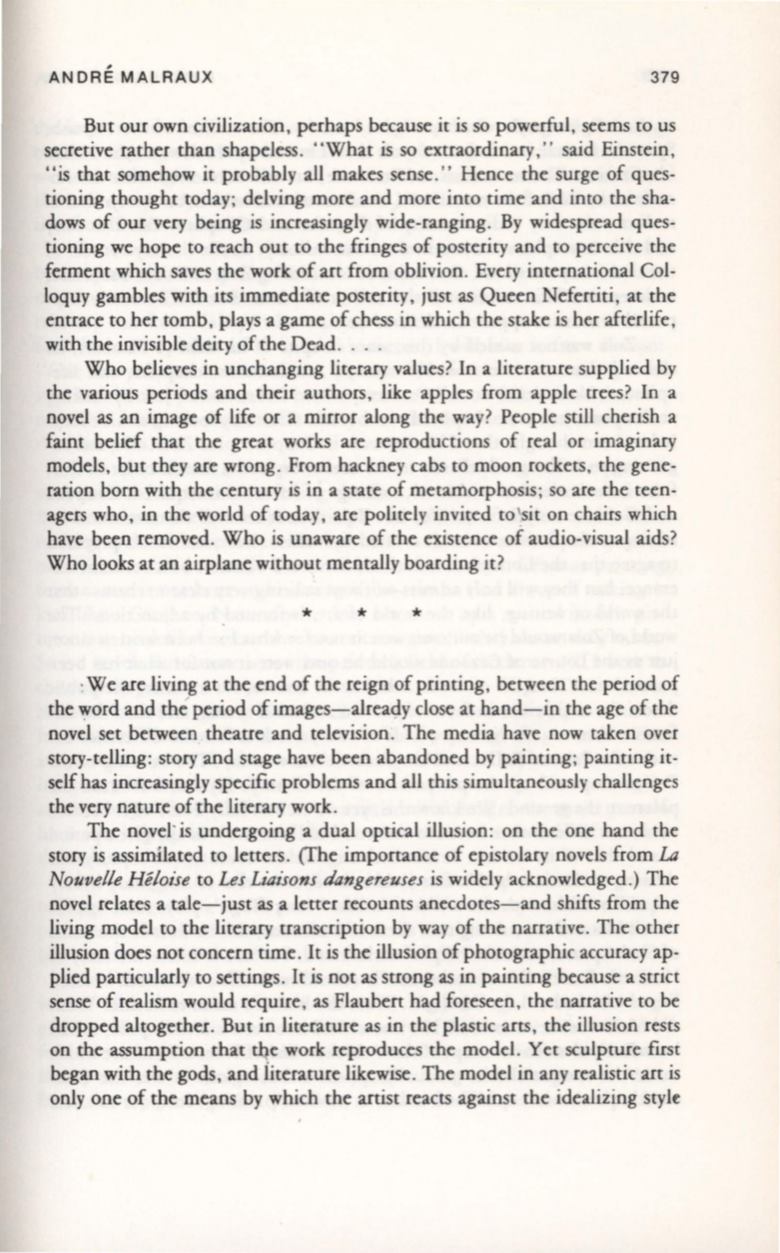
ANDRE MALRAUX
379
But our own civilization, perhaps because it is so powerful , seems to us
secretive rather than shapeless . ..What is so extraordinary, " said Einstein ,
"is that somehow it probably all makes sense. " Hence the surge of ques–
tioning thought today; delving more and more into time and into the sha–
dows of our very being is increasingly wide-ranging. By widespread ques–
tioning we hope to reach out to the fringes of posterity and to perceive the
ferment which saves the work of art from oblivion . Every international Col–
loquy gambles with its immediate posterity, just as Queen Nefertiti, at the
entrace to her tomb, plays a game of chess in which the stake is her afterlife ,
with the invisible deity of the Dead . .. .
Who believes in unchanging literary values? In a literature supplied by
the various periods and their authors, like apples from apple trees? In a
novel as an image of life or a mirror along the way? People still cherish a
faint belief that the great works are reproductions of real or imaginary
models, but they are wrong. From hackney cabs to moon rockets , the gene–
ration born with the century is in a state of metamorphosis; so are the teen–
agers who, in the world of today, are politely invited to 'sit on chairs which
have been removed . Who is unaware of the existence of audio-visual aids?
Who looks at an airplane without mentally boarding it?
* *
*
.Weare living at the end of the reign of printing, between the period of
the 'Yord and the period of images-alreac,iy close at hand- in the age of the
novel set between theatre and television . The media have now taken over
story-telling: story and stage have been abandoned by painting; painting it–
self has increasingly specific problems and all this simultaneously challenges
the very nature of the literary work .
The novel' is undergoing a dual optical illusion: on the one hand the
story is assimilated to letters. (The importance of epistolary novels from
La
Nouvelle Heloise
to
Les Liaisons dangereuses
is widely acknowledged.) The
novel relates a tale-just as a letter recounts anecdotes-and shifts from the
living model to the literary transcription by way of the narrative. The other
illusion does not concern time.
It
is the illusion of photographic accuracy ap–
plied particularly to settings .
It
is not as strong as in painting because a strict
sense of realism would require, as Flaubert had foreseen, the narrative to be
dropped altogether. But in literature as in the plastic arts , the illusion rests
on the assumption that tQe work reproduces the model. Yet sculpture fust
began with the gods, and iiterature likewise . The model in any realistic art is
only one of the means by which the artist reacts against the idealizing style


